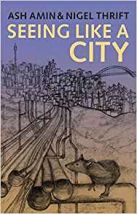Seeing Like a City

The authors of Seeing like a City acknowledge their title has been used before, but they openly borrow it. The scholarship in this book presents “cities as forcing houses” (page 1). In other words, Amin and Thrift believe that the tentacles of cities reach everywhere and “are sustaining a new era of ‘planetary urbanization’” (page 1). The aim of their book is therefore to get to the “citiness” of cities – to search beyond spatial concentration and to get “close to the combinational machinery” of the city. In particular, they seek to examine “the combined vitality and political economy of urban sociotechnical systems” and identify how the overlapping of these systems gives cities their world-making power (pages 2 and 3).
Chapter 1, “Looking through the City”, considers how cities have become so influential and transformative in the Anthropocene. Amin and Thrift say this is due to the presence and absence of key attributes and how this combined ecology “forces the reconsideration of the staples of urban agency and analysis” (page 9). They start by exploring the world significance of cities and they close by discussing how to know the complex city by broadening our spectrum of urban knowledge.
Chapter 2, “Shifting the Beginning: The Anthropocene”, claims that infrastructure was the foundation of cities and that cities then begat the Anthropocene. On this basis, Amin and Thrift pursue their thesis “that the city is an infrastructural entanglement with considerable formative agency”, and this is why cities are both the producer of, and product of, the Anthropocene (page 33). A significant argument across both Chapters 1 and 2 is that cities provide the main impetus behind political economy (page 9).
In Chapter 3, “How Cities Think”, Amin and Thrift discuss humans as a spatial product. They consider what happens when humans are broken apart and reassembled in cities, and finally what happens when the city starts to think for itself and humans find themselves in something by definition extra-human (page 70). The last two chapters of this book turn back to cities as composites in order to discuss how urban prosperity and poverty are settled (page 100).
In Chapter 4, “The Matter of Economy”, the authors “develop an alternative account of how cities influence economic performance” – specifically that the sociotechnical systems of cities influence this (page 102). Here, Amin and Thrift set out to explain urban prosperity, look at the substrates of urban productivity, and highlight meshwork urbanism. They conclude that urban infrastructures are in fact part of the biopolitical machinery of cities (page 120).
The final chapter, “Frames of Poverty”, describes the intensities and distributions of urban poverty, and considers the significance of how poverty is both calculated and framed. It goes on to show how infrastructure also affects the meaning and measurement of urban poverty, as well as its alleviation (pages 125 to 126). After considering standard policy solutions for urban poverty, Amin and Thrift conclude by returning to “a politics of basic provisioning”, believing that only with this is large-scale poverty reduction possible (page 129). They end by noting that this draws attention once again to the hidden power of the city as a sociotechnical machine.
Book note prepared by Hannah Keren Lee
Search the Book notes database
Our Book notes database contains details and summaries of all the publications included in Book notes since 1993 - with details on how to obtain/download.
Use the search form above, or visit the Book notes landing page for more options and latest content.
For a searchable database for papers in Environment and Urbanization, go to http://eau.sagepub.com/

